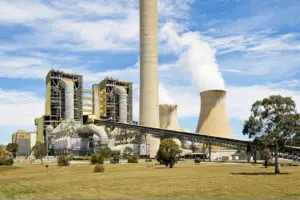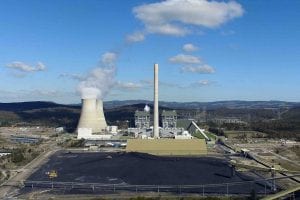Big generators and other players in Australia’s energy markets are using energy minister Angus Taylor’s search for new “24/7” base-load power generation, and his preference for coal and gas investments, as an opportunity to push for so-called “capacity” payments in the market.
Taylor, on Wednesday, held two meetings with industry. The first didn’t turn out well, with the big retailers rejecting his demands that they cut the level of standing offers, agreeing only on the formulation of “comparison rates” that a consumer might be better able to comprehend.
There was more engagement with Taylor’s second meeting of the day – to get feedback on the Coalition government’s equally controversial proposal to underwrite new investment in “dispatchable generation”, which he defines as 24/7 power, and which many fear is a de-facto call to extend the life of ageing coal generators, or even investment in new facilities.
But according to those at the meeting – which included representatives from a range of energy peak bodies, consumer groups, bankers, the big three gen-tailers, smaller retailers and some renewable energy companies – it was not made clear if any new capacity was actually needed.
There were also questions about whether the government had bothered to involve the Australian Energy Market Operator, which runs the grid, has produced a 20-year blueprint for the future, and sees no pressing issues of reliability apart from the need to replace the Liddell generator before it closes in 2022.
AEMO was not at the Sydney meeting, nor is there any indication that is has been consulted on Taylor’s stated wish, reinforced on Wednesday ahead of the meeting as a push for new investment in coal, gas or pumped hydro.
RenewEconomy understands that AEMO will be consulted once Taylor advances his program and “it gets into actual projects and their viability.” The consultation paper released last week was written by Taylor’s department.
Taylor reinforced his push for base-load by telling Radio 2GB on Wednesday afternoon: “It’s got to be 24/7 power. Coal is one option, it’s not the only one.”
AEMO’s Integrated System Plan makes no mention of the need for new 24/7 power, and neither do utilities like Origin Energy who plan to exit coal. AEMO speaks only of the need for “dispatchable” and flexible capacity.
Attendees said Taylor told the meeting his move was driven by the fact that he could see no investment in dispatchable generation.
Yet, there was no mention of the significant push for battery storage, nor even of Snowy 2.0, owned by the government’s own energy utility, Snowy Hydro, which manages the hydro-electric scheme that Taylor’s grandfather helped design.
Taylor is also working with the Energy Security Board in its push for a reliability obligation under what is left of the NEG, but Taylor’s view is that this will not trigger immediate investment, and he wants something to be locked in quickly – at least before the next election, due by mid-May.
Taylor attended the meeting with representatives from the department, and former Deutsche Bank analyst John Hirjee, now acting as an advisor. Another meeting will be held in Melbourne on Friday.
Taylor intends to play a hands-on role in the process, saying he would be reading the submissions to the proposal himself. Taylor used to work with consultancy Port Jackson Partners, where current ACCC chairman Rod Sims was also a partner.
Taylor wants a formal tender for this new investment to be locked away before the next election, and is rushing through the process, calling for submissions to be tendered by the end of this week.
According to those present, Taylor had planned to break the meeting into orderly sections about mechanism, bankability, merit criteria and implementation, but as one observer noted, “it quickly turned into an unstructured mess.”
Several people told RenewEconomy the conversation was dominated by Trevor St Baker, the co-owner of the Vales Point coal powered station in NSW that Sunset Power picked up for a bargain. Sunset now wants to extend the life of Vales Point , and is also looking at the Goat Hill pumped hydro project in South Australia.
St Baker is playing an increasingly prominent role in the national energy debate, addressing the Monash Forum of the Coalition’s coal-enthusiasts, and echoing their and Taylor’s concerns about the level of “intermittent” wind and solar on the grid.
St Baker has previously claimed that the International Energy Agency has recommended that an “instantaneous limit” of 50 per cent of wind and solar at any one time be imposed, and used Ireland as an example.
We called out that and other similar claims for the bunkum that they were. St Baker was still talking about Ireland at the meeting, saying Australia should adopt its practices, even though it is a completely different market with markedly different resources.
Interestingly, Ireland sets an “instantaneous” limit of 65 per cent for wind energy, and intends to lift this to 75 per cent.
That’s in the ball-park of the existing constraint imposed in South Australia by the Australian Energy Market Operator, which won’t allow more than 1295MW of wind (or large-scale solar) without enough thermal generation on-line, but it is looking to relax those restrictions.
Ireland’s curtailment levels are about the same as South Australia’s – around 4 per cent – although it reported that in some periods of high wind capacity, curtailment is reaching 10 per cent, similarly to Ireland. California is experiencing a massive “duck curve” caused by the huge installations of solar, but is also investing in storage to soak up some of that excess production.
St Baker said his company would favour either capacity payments or a “floor price”, which Anthony Tallon, another executive at Sunset Power, said could help extend the life of Vales Point for another 10-15 years. Curiously, St Baker observed that the level of renewables in NSW was not yet at a point to cause an issue, attendees told RenewEconomy.
The call for capacity payments was echoed by a range of different players, including long-time advocate AGL, represented by Richard Wrightson, Twiggy Forrest’s Australian Industrial Energy, which proposes a gas import terminal, and New Zealand infrastructure investor Morrison and Co, whose representative Paul Newfield suggested that thermal coal generation would not be competitive in a future market.
Capacity payments are often criticised as subsidies to existing fossil fuel generators, and applied badly that is exactly what they are. In Western Australia, for instance, they have resulted in massive over-payments to generators, some of which have never been turned on and have sat there uselessly pocketing money handed over by consumers.
St Baker and others are pushing for them because the proposed reliability obligation is considered “too light a touch” and contractual, and may not protect coal generators from spot market price exposure – particularly price dips. It’s an assured revenue stream from the capacity, whether they generate or not.
One of the reasons for this whole underwriting investment piece is that Angus Taylor’s view is the RRO could bring on capacity but is unlikely to be particularly quick, and we need something straight away and particularly in the interim as RRO market liquidity develops.
Some do favour them, noting that they keep a lid on the huge variations in the energy market price which are becoming increasing unpalatable in the political arena. But to do so on a wholesale basis effectively redesigns the system.
However, there are one-offs, such as the Tesla big battery in South Australia, which receives what amounts to an annual capacity payment of $4 million from the South Australia government to provide grid services in the case of an emergency.
AEMO’s RERT mechanism, which calls for fast-acting capacity to respond to urgent needs at times of peak demand in the heat of the summer, operates on a broadly similar principle.








